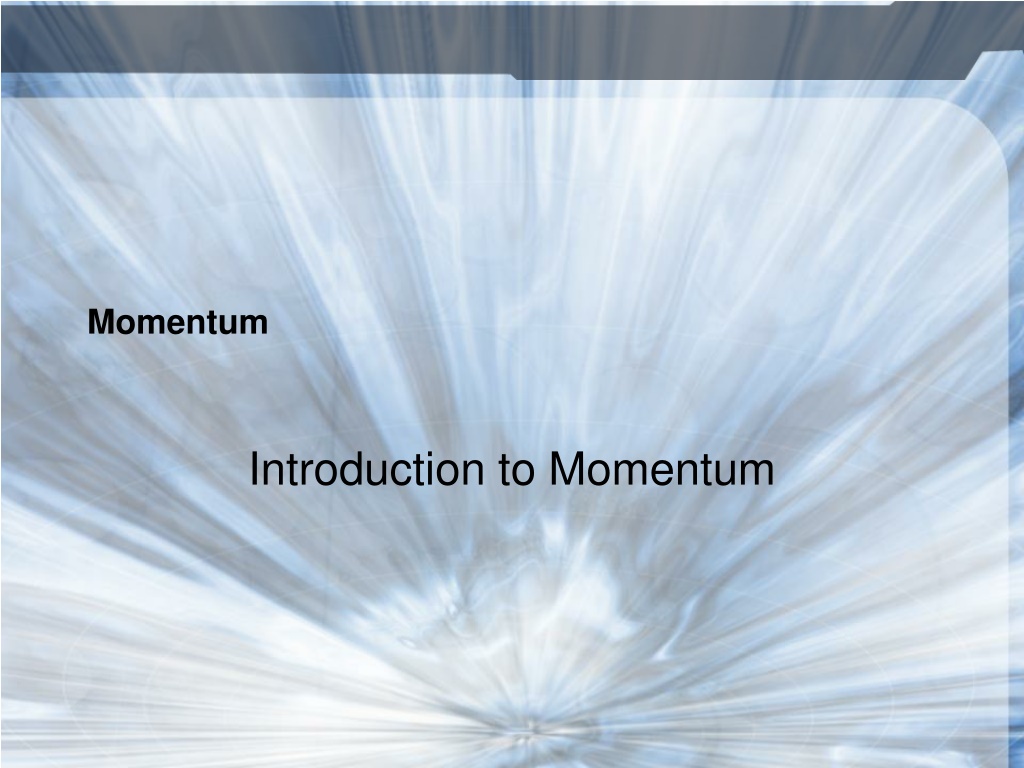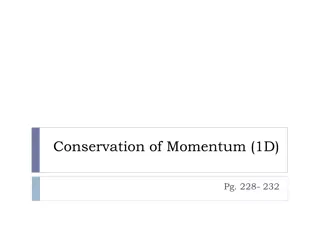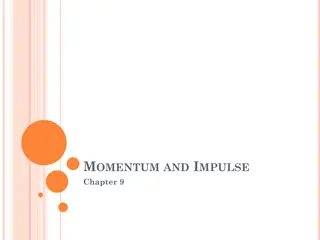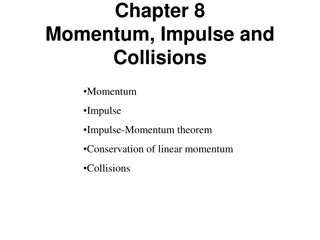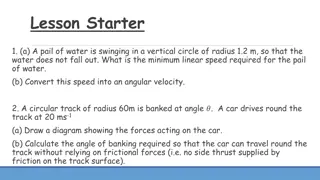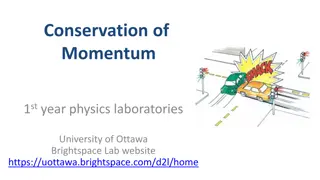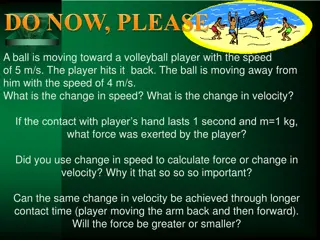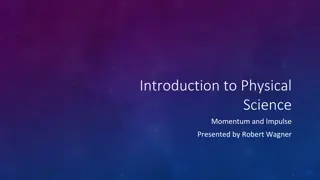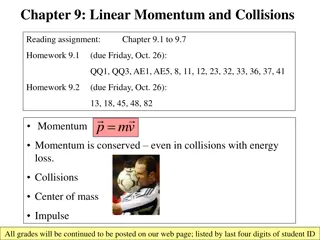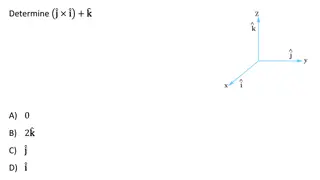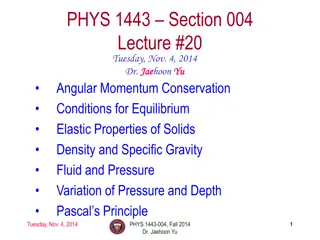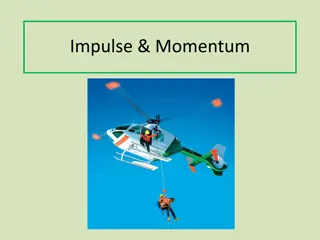Understanding Momentum in Physics
Explore the concept of momentum and how it relates to the motion of objects. Learn how to calculate momentum, find velocity, and understand impulse in this comprehensive guide. Engage with examples and interactive questions to deepen your understanding of this fundamental concept in physics.
Download Presentation

Please find below an Image/Link to download the presentation.
The content on the website is provided AS IS for your information and personal use only. It may not be sold, licensed, or shared on other websites without obtaining consent from the author. Download presentation by click this link. If you encounter any issues during the download, it is possible that the publisher has removed the file from their server.
E N D
Presentation Transcript
Momentum Introduction to Momentum
What is Momentum? The quantity of motion of a moving body Depends on mass and velocity Measured by multiplying mass to the velocity Vector Measured in kg*m/s or N*s
How is momentum measured? Momentum = mass x velocity p=mV p=momentum m=mass (kg) V=velocity (m/s)
Example Calculate the momentum of a 6.2 kg pumpkin traveling at a velocity of 5.0 m/s west.
Clicker Question A baseball of mass 0.14 kg is moving at 35.0 m/s. Find the momentum of the baseball. A)4.9 B)1.4 C)35 D)250
Clicker question Find the velocity of a bowling ball with a mass of 7.6 kg and a momentum of 4.9 kg m/s. A)283 B)37.2 C)0.64 D).20
Impulse-Change in Momentum When an object stops or changes its velocity the momentum changes p=m V Or p=m(Vf-Vi)
Example A 0.50 kg water balloon is thrown against a wall at 32 m/s coming to a stop. What was its change in momentum?
Clicker Question A 0.50 kg bouncy ball is thrown at 32 m/s, bouncing back with the same speed. How does its change in momentum compare to that of the water balloon? A) -32 kg m/s so twice as large B) There is no difference C) There is 0 change in momentum
Momentum Momentum-Impulse Theory
What is impulse? It is the change in momentum ( p) p=m V or m(Vf-Vi) The impulse-momentum theorem states that when a net force is applied to an object over a certain time interval, the force will cause a change in the object s momentum. So Impulse can be defined as the product of the force and the time in which the force is acting on an object p=F t So F t=m V
Example Luigi is sick of taking orders. He swings a 9.0 kg hammer at 16 m/s when Mario s mustache brings it to a stop in 0.25 s. What is the net force exerted on Mario s mustache?
Clicker Question A soccer player kicks a 0.450 kg ball at 25.0 m/s east. If the goalie stops the ball by exert 215 N of force, how long does it take the ball to stop? A)2418 s B)0.052 s C)3 s D)1 s
Clicker Question If the goalie stops the 6.5 kg bowling ball traveling at the same velocity in the same amount of time, how much force is required? A)6000 B)3250 C)2000 D)1000
Discuss Coaches for many sports such as baseball, tennis and golf can often be heard telling their athletes to follow through with their swing. How does this help a weaker player hit a ball farther than a stronger player? Use the momentum-impulse theory
Discuss Using the principle of impulse, explain why an airbag can help people sustain less damage during a collision.
Momentum Law of Conservation of Momentum
Recall Newton s 3rdLaw Every action force has an equal and opposite reaction force Two colliding objects experience equal and opposite forces for the same amount of time, then their impulses must be equal and opposite
Example A cue ball is traveling with a momentum of 5 kg m/s east and strikes the 8 ball. If the cue ball comes to a stop what is the change in momentum on the cue ball? How about on the 8 ball?
Example A clown is stuck on a sheet of frictionless ice. He hurls one of his clown shoes with momentum of 80 kg m/s east. What is his momentum before and after he throws his shoe?
A fullback is traveling to the right with a momentum of 120 kgm/s while a linebacker is traveling to the left with a momentum of 110 kgm/s. If they stick together, what is their total momentum before and after they collide
Law of Conservation of Momentum In an isolated system, momentum is not created or destroyed during any interaction (collision) An isolated system means no external forces act on the system Total initial momentum = Total final momentum pi=pf m1V1i+ m2V2i= m1v1f+ m2V2f
Elastic Collision A collision in which the total momentum and the total kinetic energy are conserved is called an elastic collision The objects will separate from each other after the collision m1V1i+ m2V2i= m1v1f+ m2V2f
Example A 7.1 kg bowling ball is rolling to the right at 3.8 m/s when it collides with a stationary 0.40 kg bowling pin. After the collision, the bowling ball is traveling at 2.9 m/s to the right. How fast is the pin moving after the collision?
A 0.25 kg cue ball is traveling east at 4.5 m/s when it collides head on with a 0.25 kg eight ball traveling west at 5.0 m/s. After the collision the cue ball Is traveling west at 2.0 m/s. What is the final velocity of the eight ball A) 4.5 m/s B) 1.5 m/s C) 9.5 m/s D) 2.0 m/s
Inelastic Collisions A collision in which two objects stick together after colliding and move together as one mass is called a perfectly inelastic collision. m1V1i+ m2V2i= (m1+ m2)Vf
Example A 0.105-kg hockey puck moving at 48 m/s is caught by a 75-kg goalie at rest. If the ice is frictionless, at what velocity will the goalie slide on the ice after catching the puck?
Clicker Question A 35.0-g bullet strikes a 5.0-kg stationary wooden block and embeds itself in the block. The block and bullet move together at 8.6 m/s. What was the original velocity of the bullet? A) 12 m/s B) 9.9 m/s C) 1200 m/s D) 40 m/s
Explosions In a situation in which you have one object separate into pieces The initial momentum is zero The law of conservation will still apply here 0 = m1v1f+ m2V2f
Example A 0.050 kg bullet is fired from a 5.0 kg gun. If the velocity of the bullet is 275 m/s, what is the recoil velocity of the gun?
Clicker Question A firecracker sits in a 7.0 kg pumpkin. After It explodes, the pumpkin splits into two chunks. A 5.0 kg piece travels west at 10.0 m/s. What is the mass and velocity of the other piece? (Ignore the mass of the firecracker) A) 25 m/s B) 40 m/s C) 10 m/s D) 50 m/s
